Discover the Jackalberry tree (Diospyros mespiliformis) in Marloth Park and Kruger — its ecology, wildlife role, conservation, and why you’ll remember it on safari.
Butterflies of the Lowveld: Jewels of the Bushveld
Discover the butterflies of the Lowveld — colourful, resilient, and vital to the bushveld ecosystem around Needles Lodge and Marloth Park.
There’s a special kind of magic in the Lowveld — sunlight shimmering through marula trees, cicadas singing in the afternoon heat, and flashes of colour weaving through the air. Butterflies — the bushveld’s living jewels — are small wonders that bring quiet grace to the wilderness.
Around Needles Lodge in Marloth Park, they drift between flowering shrubs and acacia thickets, each species carrying its own story of adaptation and beauty. These are the soft-winged ambassadors of the bush: delicate, fleeting, and essential.
If you’ve ever marvelled at the bush’s quieter life — the skinks darting through leaf litter or the geckos clinging to warm walls — you’ll know how much wonder lies in the small things. (Read more in Lizards of the Lowveld: Tiny Dragons of the Bushveld.)
Let’s meet some of the Lowveld’s most captivating butterflies — up close and in their element.
Citrus Swallowtail (Papilio demodocus)
Perhaps the most recognisable butterfly in southern Africa, the Citrus Swallowtail is large, confident, and full of character. Its wings flash bright yellow and black as it glides effortlessly through gardens and woodland edges. Around Needles Lodge, they’re often seen visiting wildflowers or hovering near citrus trees planted in nearby gardens.
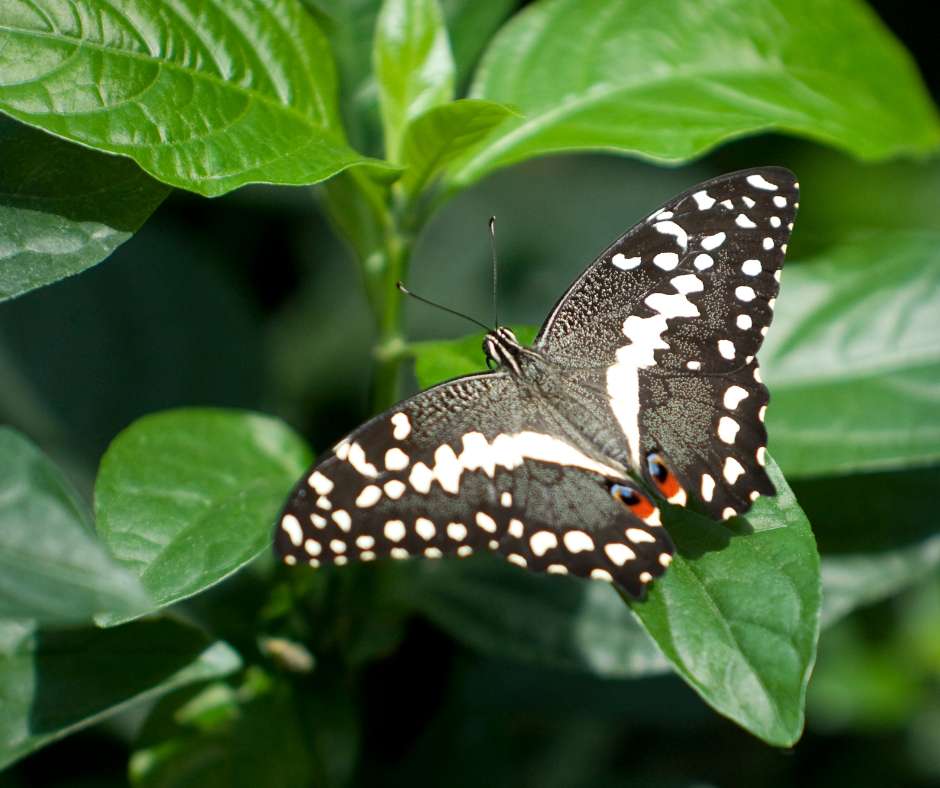
Habitat
Prefers sunny open spaces, woodland clearings, and gardens where citrus trees grow. Around Marloth Park, they’re drawn to flowering shrubs and occasionally visit lodge gardens in search of nectar.
Behaviour
A powerful flyer, the Citrus Swallowtail can be seen patrolling its territory with slow, deliberate wingbeats. Males often engage in gentle aerial duels over favourite perches, while females lay eggs on lemon and orange trees. The caterpillars — plump, green, and comically bird-dropping-like — are masters of disguise.
Did You Know?
- 🦋 The Citrus Swallowtail is part of the same family as the famous swallowtails of Europe and Asia.
- 🦋 The caterpillar’s mimicry of bird droppings is one of nature’s most effective camouflage strategies.
- 🦋 Adults have a wingspan of up to 12 cm, making them one of the largest butterflies in the Lowveld.
African Monarch (Danaus chrysippus)
Drifting lazily through the bushveld, the African Monarch — also known as the Plain Tiger — is instantly recognisable by its orange wings with black and white borders. Graceful and unhurried, it embodies the tranquillity of the Lowveld.
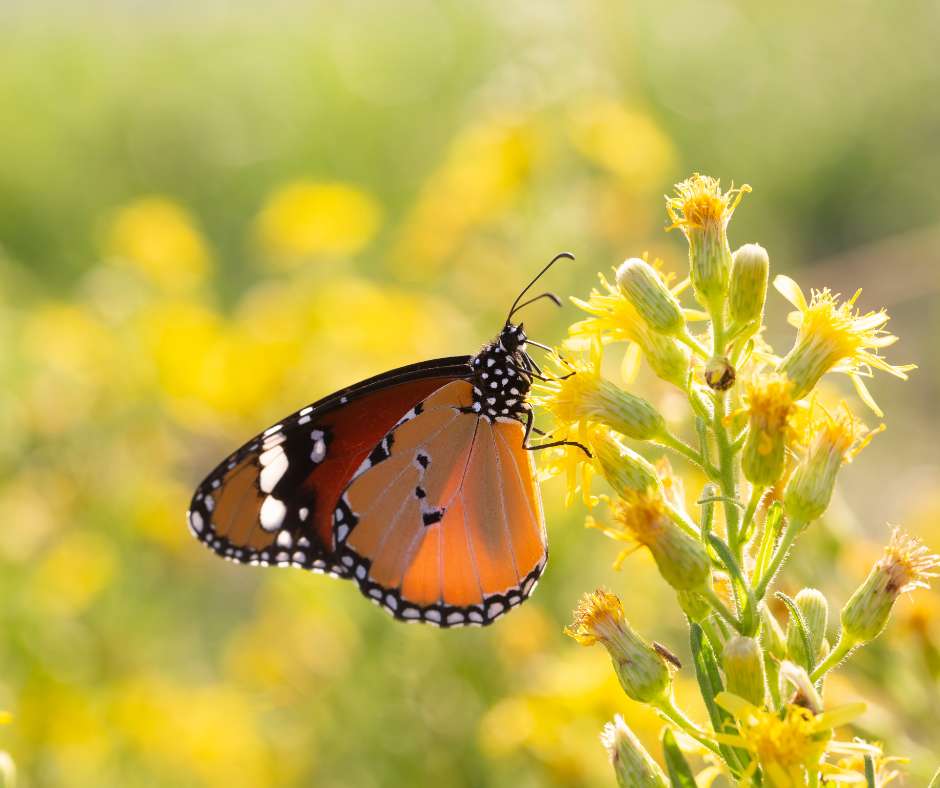
Habitat
Thrives in open savanna, roadsides, and gardens with milkweed (its caterpillar’s preferred food). Commonly seen around Needles Lodge and along Marloth Park’s sandy tracks where milkweed grows naturally.
Behaviour
Monarchs are strong yet gentle fliers. They move with a gliding rhythm, rarely hurried, often pausing to feed from wildflowers. Their caterpillars feed on milkweed, absorbing its toxic sap — which renders the adults distasteful to predators.
Did You Know?
- 🦋 Birds quickly learn not to eat African Monarchs after just one bitter taste.
- 🦋 This species inspired the name “Plain Tiger” due to its tawny-orange colouring.
- 🦋 Monarchs are part of one of the world’s most studied butterfly families, famous for mimicry and migration.
Diadem (Hypolimnas misippus)
At first glance, you might mistake the Diadem for a Monarch — and that’s exactly the point. This clever mimic evolved to copy the Monarch’s colours, fooling predators into thinking it’s just as toxic.
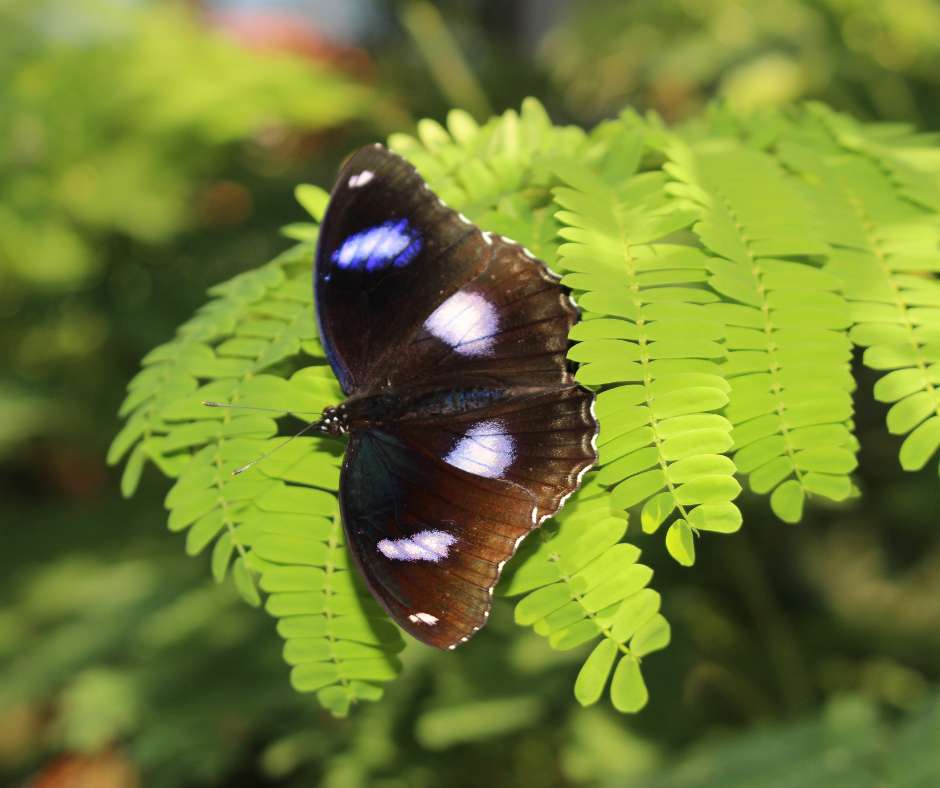
Habitat
Found in open woodland and bushveld, especially in areas with flowering shrubs. Around Marloth Park, Diadems are often seen near Needles Lodge gardens, mingling with real Monarchs.
Behaviour
The Diadem’s flight is smooth and floating, with frequent stops to feed on nectar. Males patrol small territories, while females vary in colour — some almost identical to the Monarch, others uniquely patterned.
Did You Know?
- 🦋 The Diadem is one of Africa’s best examples of Batesian mimicry, where harmless species imitate harmful ones.
- 🦋 Female Diadems can display up to seven different forms, depending on region and genetics.
- 🦋 Despite looking delicate, they’re hardy travellers and can cover impressive distances.
Blue Pansy (Junonia oenone)
Few butterflies rival the Blue Pansy for pure brilliance. Its upper wings flash with iridescent blue and violet, while the underside mimics dry leaves — beauty and camouflage combined in one design.
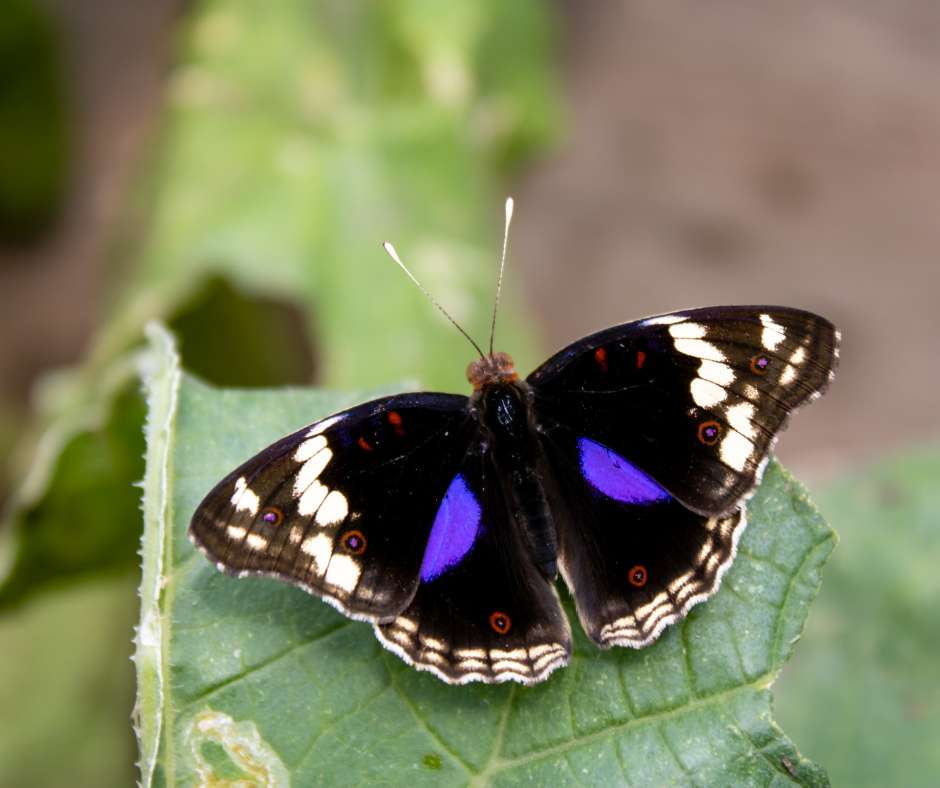
Habitat
Prefers open clearings, roadsides, and lodge gardens with abundant sunshine. The Needles Lodge garden, rich in indigenous flowering plants, is an ideal spot to find them basking in the morning light.
Behaviour
Blue Pansies are often seen resting on the ground with wings wide open, soaking up the sun. Males are territorial and will chase away rivals from their chosen patch of light. Females are more secretive, flying low to the ground when seeking host plants.
Did You Know?
- 🦋 The Blue Pansy’s brilliant colour comes not from pigment but from light refraction on microscopic wing scales.
- 🦋 When threatened, it closes its wings to reveal a dull, leaf-like underside that hides it completely.
- 🦋 The species name “oenone” refers to a Greek mythological nymph — a fitting title for such beauty.
Brown-veined White (Belenois aurota)
A symbol of change and movement, the Brown-veined White is Africa’s great traveller. Every year, millions of these small white butterflies embark on a mass dispersal, with successive generations flying northward across the Lowveld in shimmering clouds. Originating from the drier western interior, they move in search of better food sources following the seasonal rains.
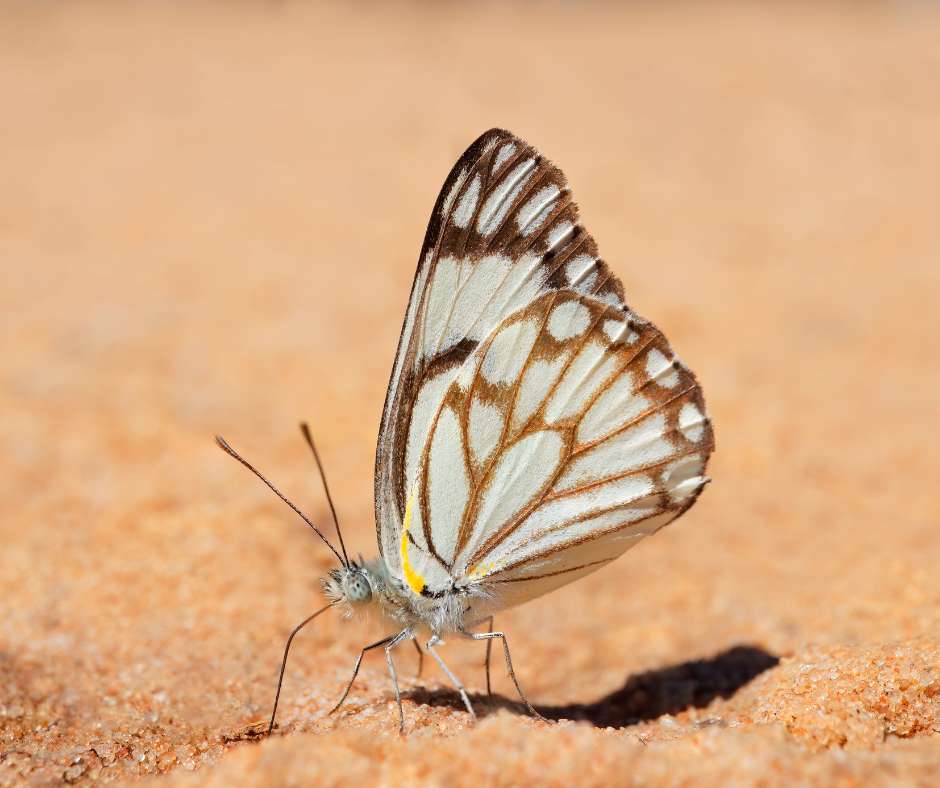
Habitat
Common across grasslands and bushveld, they are a frequent sight during the migration season. During this time, they can be seen everywhere from Kruger's plains to the gardens of Marloth Park, sometimes even appearing in overwhelming numbers.
Behaviour
Unlike a true migration where individuals return, this is a one-way, mass dispersal. Butterflies in the collective swarm fly steadily in one direction, only pausing to lay eggs on their host plants. Most butterflies complete only a portion of the journey before they die. The next generation continues the flight, sustaining the movement across a vast distance.
Did You Know?
- 🦋 This annual dispersal, carried out over generations, can stretch for hundreds of kilometers, making it one of Africa’s most visible natural spectacles.
- 🦋 Locals sometimes mistake their vast swarms for falling ash or snow, especially when the butterflies travel in massive numbers.
- 🦋 The species is one of Africa’s great travellers, and its movements are strongly linked to rainfall and the availability of their food plants, particularly species in the caper family.
If you enjoy witnessing nature’s grand migrations and subtle cycles, you might love our post on Discovering the Magic of Nature: Unforgettable Activities in the Lowveld.
Southern Gaudy Commodore (Precis octavia sesamus)
The Southern Gaudy Commodore is one of the Lowveld’s most extraordinary butterflies—flamboyant in name and in nature. What makes it so remarkable is its ability to appear in two completely different forms depending on the season, a characteristic known as seasonal polyphenism.
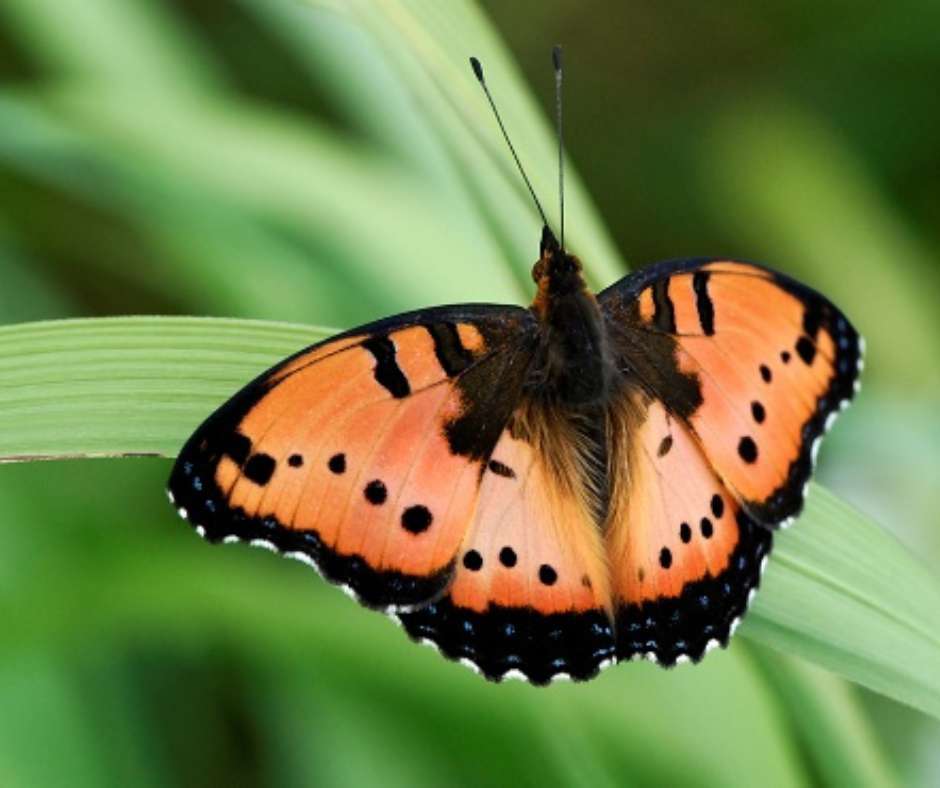
Habitat
This butterfly prefers open woodland and rocky slopes. It is a common sight in the areas surrounding Marloth Park, especially after rain when wildflowers bloom, providing ample nectar sources.
Behaviour
In summer, during the wet season, the Southern Gaudy Commodore flaunts fiery red wings with distinct black and white markings. In winter, during the dry season, it transforms into a deep, vivid blue and orange version of itself. Both forms are the same species but adapt to seasonal changes in temperature and light. Dry season forms are often seen hiding in shady areas or under overhanging rocks.
Did You Know?
- 🦋 The Southern Gaudy Commodore's summer and winter forms were once thought to be two separate species due to their dramatic differences in appearance.
- 🦋 Its seasonal polyphenism is one of the most spectacular examples of natural adaptation in Africa.
- 🦋 Males of the summer form are known for "hilltopping" behavior, perching proudly on rocks or pathways to attract females—a true bushveld showman.
Common Leopard (Phalanta phalantha)
As its name suggests, the Common Leopard wears spots worthy of its big-cat namesake. Its orange-gold wings are marked with black rosettes, making it one of the most photogenic species in the Lowveld.
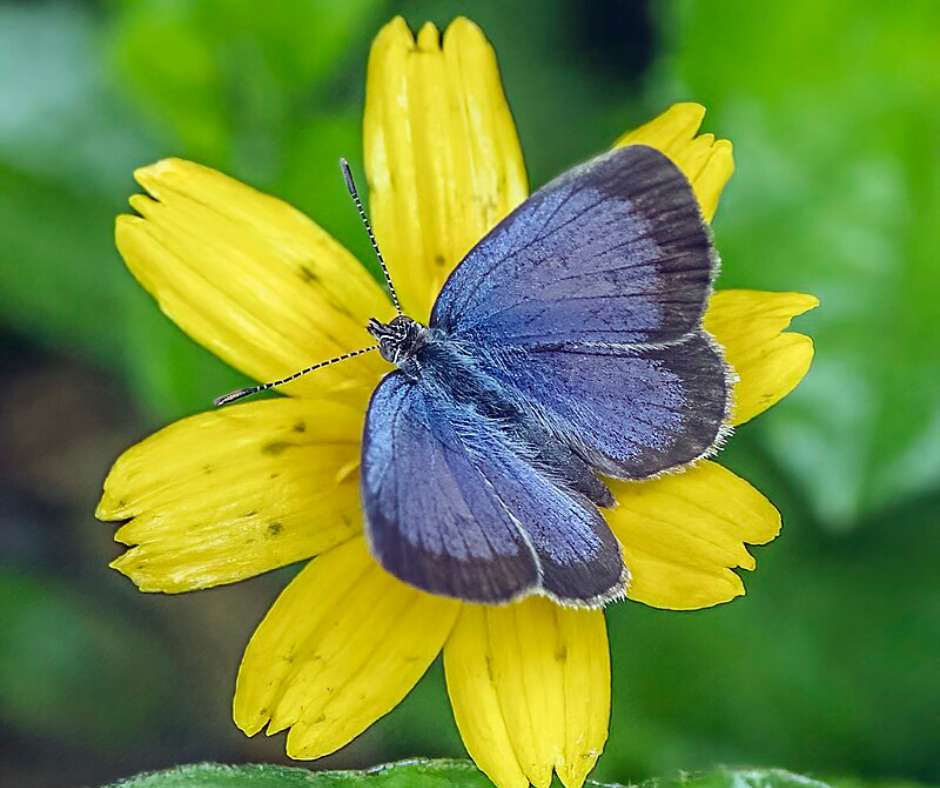
Habitat
Favours open woodland, forest edges, and gardens with flowering shrubs. Seen regularly along Needles Lodge’spathways and in Marloth Park’s sunlit thickets.
Behaviour
Restless and energetic, the Common Leopard flits constantly between patches of sunlight, never settling for long. Males patrol territories with determined speed, while females search for host plants to lay their eggs.
Did You Know?
- 🦋 The Common Leopard belongs to the same family as the admirals and fritillaries of Europe.
- 🦋 Despite its small size, it’s a strong, fast flyer capable of travelling several kilometres in a day.
- 🦋 Its larvae feed on wild passionflower vines, common in the Lowveld.
African Grass Blue (Zizeeria knysna)
Tiny, delicate, and easy to miss, the African Grass Blue is one of the Lowveld’s most understated beauties. Its soft, powder-blue wings shimmer faintly in sunlight, vanishing into the background when folded.
Habitat
Found in open grassy areas and near the edges of paths. Often seen close to the ground around Marloth Park and in the indigenous lawns of Needles Lodge.
Behaviour
This species stays close to the ground, flitting low among grasses in short, rapid flights. It feeds on tiny flowers and rests frequently, wings closed tight. Its small size makes it vulnerable — yet it thrives thanks to stealth and adaptability.
Did You Know?
- 🦋 One of South Africa’s smallest butterflies, with a wingspan of just 2 cm.
- 🦋 Its subtle colouration changes with light, appearing sky-blue at noon and silver in shade.
- 🦋 A good indicator of healthy grassland ecosystems.
Guardians of the Bushveld
Butterflies are more than symbols of beauty — they’re vital threads in the Lowveld’s ecological web. By pollinating flowers, feeding other species, and signalling ecosystem health, they help keep the bush alive and balanced.
At Needles Lodge, guests often find that watching butterflies becomes a form of meditation — a quiet moment of wonder that connects you to the rhythm of the wild. For bird enthusiasts, this same attention to detail can transform a safari — as explored in our post on Birding in Kruger: The Best Birding Drives and Experiences.
And if you’re still planning your trip, discover why this tranquil setting offers something special in The Benefits of Choosing Marloth Park Over Other Safari Bases.
Further Reading
For solo female travelers passionate about adventure, wildlife photography, and diverse cultures, South Africa is the ultimate dream destination. Explore breathtaking landscapes, abundant wildlife, and warm hospitality in this captivating country. Discover what makes South Africa a must-visit for intrepid women like you. Dive into wildlife encounters, cultural immersions, and unforgettable experiences.
South Africa, known for its breath-taking landscapes and diverse wildlife, is also home to an extraordinary group of creatures: dung beetles. These fascinating insects, belonging to the order Coleoptera, play a crucial ecological role in the recycling of animal waste, contributing to the balance and health of the ecosystem. Let's delve into the world of dung beetles and explore their remarkable characteristics and vital contributions in South Africa.

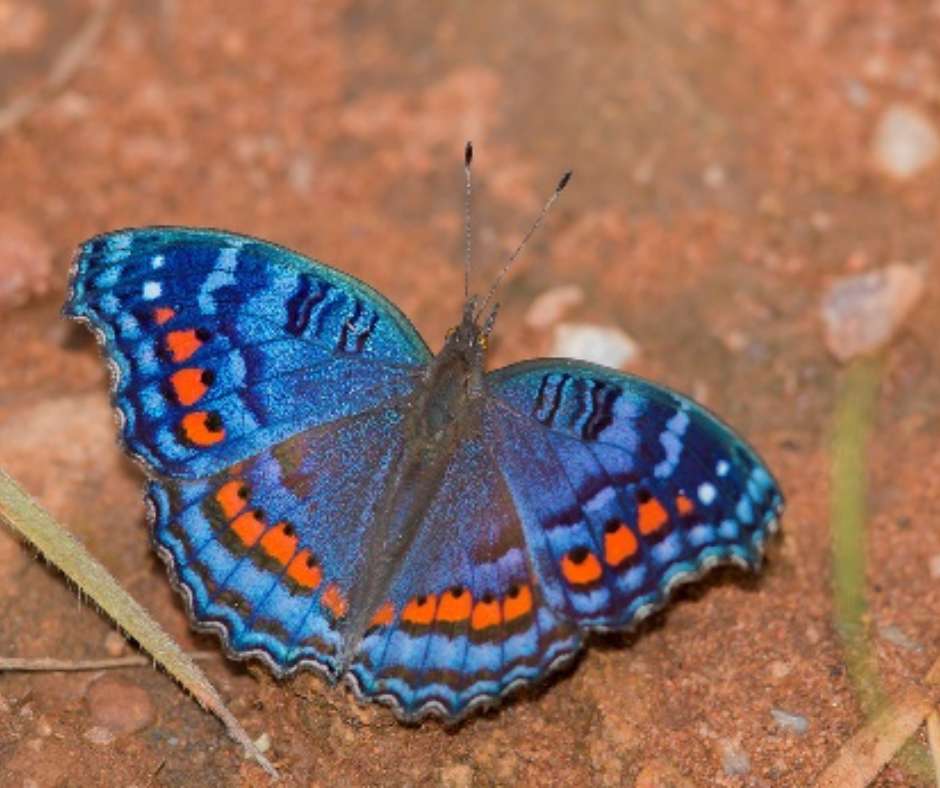
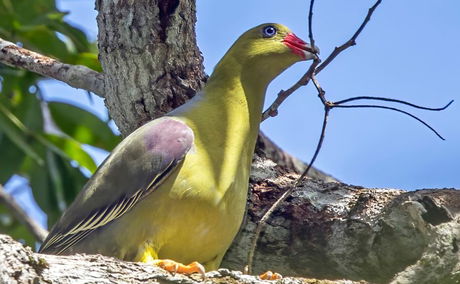

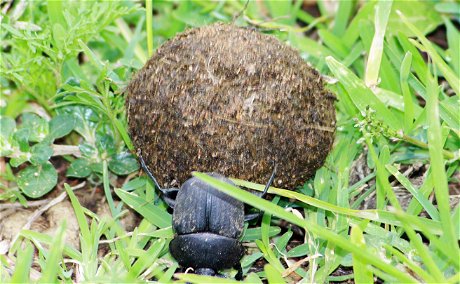
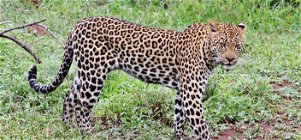
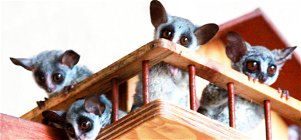
Share This Post